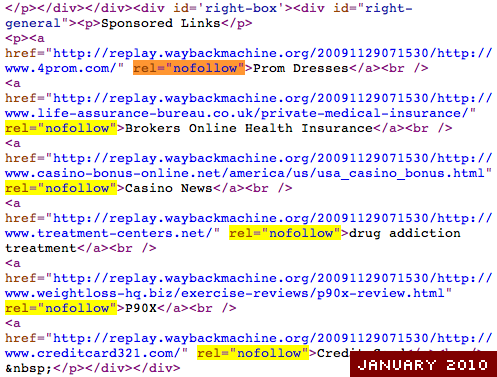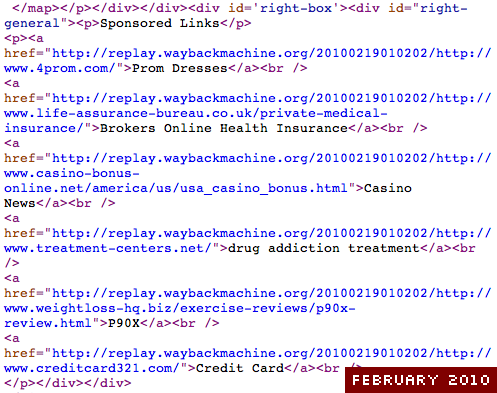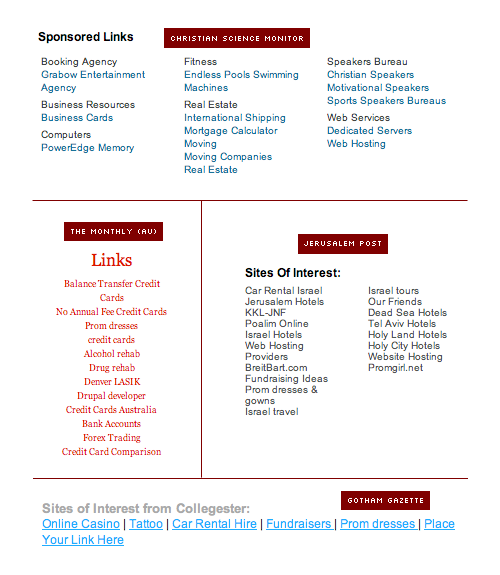
Last month, the New York Times outed retailer JCPenney for engaging in “black hat optimization” — the practice of buying or placing links designed primarily to improve a site’s standing in Google search results.
While JCPenney did a quick mea culpa and fired the SEO consultants responsible for the links (and had its search standings plummet for all the keywords involved), there is also a flip side to the story: a cautionary tale for news sites and bloggers — indeed, for anyone operating a reputable website that looks for advertising revenue.
A number of high-profile news sites, in fact, still carry links of the offending variety, potentially to the detriment of their own standing in Google search results. In a survey last week, we identified a variety of news sites publishing paid links that lack Google-required HTML formatting designed to avoid negative SEO results. The list includes GlobalPost (which has since removed the links), the Jerusalem Post, the Christian Science Monitor, The Monthly (of Australia), the Gotham Gazette (which has since made them Google-compliant by adding nofollow tags — see below), the Charleston (WV) Daily Mail and its JOA partner the Charleston Gazette.
Google frowns on paid links and similar practices as violations of its Webmaster Guidelines, and says that the practice “can negatively impact your site’s ranking in search results.” It demotes sites not only for placing purchased links, but also for “excessive reciprocal links or excessive link exchanging” and for “buying and selling links that pass PageRank.” In other words, you can lose Google Juice not only for buying the links, but for publishing them. “Pass PageRank” means that the links are detected and indexed by the Googlebot and factored into the algorithms that determine how well the result ranks for the keywords associated with the link.
To illustrate using the JCPenney case: Penney’s consultants placed lots of tiny ads, consisting simply of the word “bedding” hyperlinked to a JCPenney bedding page. Ditto for “area rugs,” “dresses,” “skinny jeans,” and tons of other merchandise categories. As Google’s engine found these and indexed them, the JCPenney pages rose to the top of search results for those keywords. In other words, JCPenney bought its way to the top of the rankings.
Google doesn’t actually mind if you buy links like that as advertising, but it requires that in each case, the link includes what’s known as a “nofollow” tag that tells the search machinery not to index the link so it doesn’t influence the rankings. This simple bit of formatting, however, negates the whole purpose of placing the links, because as advertising, they’re not particularly effective. Typically the links are placed in a cluster at or near the bottom of the page, sometimes with a heading like “Sponsored Links” or “Links of interest.” Given how low clickthrough rates are even for prominent display ads, these unobtrusive link ads are designed primarily for SEO purposes, and only incidentally in the hope that someone will actually click on them and buy something.
At GlobalPost, they were listed in a block at the bottom of the page, below all content and internal links, in a gray font that seemed designed to lower, rather than enhance, their visibility. When I contacted Rick Byrne, GlobalPost’s director of communications and marketing, last week while the ads were still on the site, he told me that following the JCPenney affair, GlobalPost had reviewed its policy with regard to the links, and, in the belief that they did carry nofollow tags, that the links were acceptable.
However, as anyone could determine via the “View Source” tool on their browser, the links at GlobalPost were “naked,” without “nofollow” tags. As soon as Byrne realized this, he ordered the links taken down pending investigation, and sent me a detailed email trail indicating that on July 17, 2009, in discussions among Byrne, CEO Phil Balboni, other executives, and Lee Goldberg, former VP at the site’s SEO consultants Prime Visibility, a firm decision was made to drop the links. Balboni’s directive at that time stated:
I am going to go with Lee’s strong recommendation here. Please take down these links as soon as reasonably possible. I have no desire to take the serious risk of having GlobalPost delisted by Google for any amount of money, let alone the small dollars at stake here.
Prime Visibility had counseled GlobalPost that (in Byrne’s words) “these kinds of links could jeopardize our standing with Google and we were not interested in having issues with the number one driver of traffic to our site.”
However, later that day, that decision was reversed upon assurances from Prime Visibility that the situation could be remedied through the use of nofollow tags. So the links stayed, appropriately tagged — as can be seen by viewing GlobalPost source code in a January 2, 2010 page archived at the Wayback Machine. But by February 2010, the tags had disappeared, and apparently never returned.


Byrne stresses that this was a mistake, resulting from an internal failure to dig deeper into whether or not the tags were there. “We regret that it did not happen, but our intentions were always honorable, and we were always focused on improving our business.” The link ads are now gone, and Byrne said that, at this point, GlobalPost does not plan to bring them back, even with nofollow tags.
At the Christian Science Monitor, paid links are in a box at the footer of the page, without a nofollow tag. Monitor ad director Bob Hanna, in an email, said that the Monitor was “comfortable that these ads have met our standards for appropriate content,” but that based on the Penney case and other recent coverage, the Monitor would evaluate whether continued publication is appropriate. So far, no change has been made.
At Gotham Gazette, the paid links are listed as “Sites of Interest from Collegester” at the bottom of its main news column. After I contacted editor Gail Robinson to inquire about the absence of nofollow links, the organization added nofollow tags to the links, but did not get back to me to explain their decision.
Other sites I contacted about this practice did not respond to my inquiries and have not added nofollow tags at this point. At those other sites (linked above), placement is similarly unobtrusive: on the Christian Science Monitor, Charleston Gazette, Daily Mail and Jerusalem Post, they’re in a footer box at the bottom of the page. The Monthly has them in its left navigation column.

That “Collegester” source listed at Gotham Gazette, with a bit of Googling, led me to Advertise U!, a Los Angeles operation which lists Collegester as a testimonial-giving client on its home page. Advertise U makes the purpose of the link ads very clear with this language:
Advertise U specializes in text link advertisements. We will link your site to a PR7 or PR8 website for a modest monthly fee. Text Link Ads help improve your rankings in search engines for the keywords of your choice.
Google “PR7 or PR8” and you’ll find yourself in an underworld of link-sellers, comment spammers, and similar operators all engaged in getting what they call “dofollow” links or “backlinks” on high PageRank (PR) sites. Advertise U says it charges up to $499 a month for a flight of Text Link Ads.
Some but not all of the paid links I found on news sites came from Advertise U. The outfit’s founder, Rasheed Richmond, on his LinkedIn profile lists Jerusalem Post among his past clients, along with the Daily Californian of U.C. Berkeley (which no longer carries them). Byrne told me that Advertise U was not the source of the links on GlobalPost, but would not disclose what agency or broker provided them.
In a 2009 document offering Advertise U for sale, Richmond confirms in a straightforward manner the nature of his text-linking business and the fact that clickthroughs are not the point: “Since most of our customers buy links for SEO/SEM (search engine optimization/search engine marketing) purposes & clicks secondly, the link location from our publishers isn’t too critical. That’s a great selling point for adding new publishers.” Richmond claimed in the document that Advertise U pays a PageRank 8 publisher between $100 and $200 per link per month, and a PageRank 7 publisher $20-$50 per month. Richmond did not respond to my request for comments.
So what’s the moral of this story? Whether you’re operating an international news site, a neighborhood blog, or anything in between, the simplest policy is not to accept paid links of any kind. They are not particularly lucrative, they provide no useful service to your readers, and they tend to be in conflict with and detract from the quality and content of your site. If you’re trying to sell display ads for BMWs, why would you accept text link ads for such things as tattoos, DUI lawyers, fundraising ideas, and (the most popular link across all the sites I found) prom dresses?
Alternatively, you could decide to publish paid links, but only with nofollow tags. Chances are, however, that your broker will turn you down (since this makes the links essentially worthless to the destination site) unless you happen to have a high PageRank site like GlobalPost, Jerusalem Post, Christian Science Monitor, or the like. The broker may be willing to accept nofollow tags on such sites simply in order to be able to point to them as clients, for the purpose of enlisting paid-link advertisers. But if you have a small-town newspaper site or regional news blog, demanding nofollow tags will likely be a dealbreaker.
If you decide to throw caution to the wind and publish paid links (or exchanged links) without nofollow tags, be prepared for your own site’s search rank to slip eventually. As Google makes clear in its guidelines, the links reflect on PageRank not only for the destination site but also for the site that sells and publishes them or engages in flagrant link exchanging. The practice will lower Google’s automated assessment of your site’s quality, which not only lowers your PageRank, but will also lower the position of any Google ads you may place to attract traffic to your site.
Finally, even if you accept the links and the broker is agreeable to nofollow tags, as illustrated by the GlobalPost story, you’ll have to keep checking to be sure the tags stay with the links. They can disappear all too easily, for example when tech or advertising personnel turns over and is unaware of the requirement. The broker will certainly not encourage nofollow tags — you’ll have to deal with that yourself.
What if you’ve been on the wrong side of this, like GlobalPost was? Best to deal with it promptly, as they did, either by taking down the links or inserting nofollow tags (if you can still get paid by doing that). But there’s a caveat, either way: make sure you go through every page on your site including old archived pages. Forbes thought they did that two years ago; then they found and cleaned up some more pages in the wake of the Penney affair; and even then it took the sleuths at TechCrunch to help them find the last bits.
As a footnote, you might have a look at how your commenting system handles links. The shady backlink optimization networkers I mentioned above would rather get free links than have to pay for them, and they do it by placing (or paying people to place) comments on older blog posts and stories. You’ve seen them — bland comments like “Nice post, I totally agree, keep up the good work.” And buried in the text or username is a link to some e-commerce site designed to enhance its search standing. The solution (which simultaneously avoids Google-juice issues and discourages comment spammers) is to use a comment system that automatically adds a nofollow tag to any link in a comment, as the Disqus system here at Lab does.